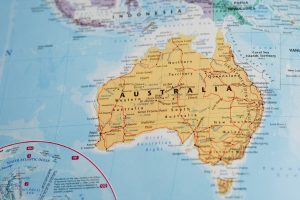As a country that straddles both the Indian and Pacific oceans, Australia has been an enthusiastic adopter of the Indo-Pacific construct. Australia has the largest Indian Ocean coastline, and so it naturally sees itself as a two-ocean power. This can be expanded to three, if you include the Southern Ocean, where Australia has major search and rescue responsibilities, as well as its Antarctic interests. Yet with the Southern Ocean not having major geostrategic influence, it is the Pacific and Indian oceans where Canberra’s attention is directed.
Recently through major defense strategy documents, Australia has redefined what it calls its “immediate region.” In addition to its traditional neighbors throughout the Pacific Islands and Southeast Asia, the designation now also includes the northeast Indian Ocean. This is an enormous region; its incorporation is a sign of Canberra’s ambition as a regional actor – or maybe its hubris.
While most analysts would see the entire Indian Ocean as a single strategic theater, Australia arguably lacks the resources to expand its vision this widely. Despite having considerable interests in the oil flows out of the Middle East, Australia’s conception of the Indo in Indo-Pacific effectively draws a line south from India’s west coast.
Limiting what is already an expansive concept of its region is understandable for a country of Australia’s size. Australia is a Pacific-heavy country, with around 80 percent of its population housed within its Pacific-facing states. Its India Ocean capabilities are lean.
Alongside this, the country’s northwest – the region facing out toward and closest to the northeast Indian Ocean – is one of the least densely populated and underdeveloped regions on Earth. To put this in context, the state of Western Australia has a land mass slightly smaller than Kazakhstan – the ninth largest country in the world by square kilometers, and has a population of just under 20 million. Yet Western Australia has a population of just 3 million people, 90 percent of whom live in its southern corner.
This clearly prevents Australia from being able to project power off its northwest coast, including an inability to develop shared economic and security interests that usually spring up from coastlines facing each other. The northeast Indian Ocean is home to a massive population of people, from Indonesia around to India, yet the natural flow of exchange from communities inhabiting the same oceanic space is missing.
Regardless of these impediments, Australia sees itself as an Indian Ocean player, and at least in terms of burgeoning naval reach with the eventual addition of the AUKUS nuclear-powered submarine fleet, this should be the case. The AUKUS fleet – when, or if, it eventually arrives in full – will give the Australian Navy a blue water capability that it currently lacks. Of course, naval capability alone is only one tool of statecraft, and cannot fully make up for deficits in other areas.
How can Australia overcome these deficits within its designated “immediate region”?
The permanent dilemma of Australian foreign policy is its relationship with Indonesia. Bar conflict zones, arguably no two close neighbors are as estranged from each other as Australia and Indonesia. Indonesia is forever deemed to be Australia’s most important relationship, but ties never actually progressed far beyond a nice sentiment. The mutual capacity-building that neighbors can construct with each other through trade and habits of cooperation looks to be stalled.
Instead Australia has leap-frogged Indonesia and looked to India. Alongside a burgeoning trading relationship and the increased diplomatic resources Canberra is dedicating, Australia sees the relationship with India as central to its Indian Ocean strategy. There has been a convergence of geopolitical interests between the two countries, primarily driven by concerns about China’s belligerence in the South China Sea, what this may mean for the Indian Ocean, and the incursions it has been making into Indian territory in India’s northwest and northeast.
Australia’s recent National Defense Strategy, released in April this year, described India as a “top-tier security partner,” and stated that Canberra will “continue to support India’s key role in the region.” Australia recognizes that India is moving toward becoming a net security provider in the Indian Ocean and Australia sees itself as augmenting this role.
Yet as with AUKUS, defense cooperation isn’t enough to provide a holistic substance to the northeast Indian Ocean as part of Australia’s “immediate region.” However, it may be Australia’s rapidly expanding Indian diaspora – now the second largest migrant group in the country – that could pull the country westward. It is this diaspora and the interests they create that will move the northeast Indian Ocean more fully into Australia’s strategic vision.
Barring the unlikely event of a swift and significant development of Australia’s northwestern coastline, these new sets of interests driven by the Indian diaspora may be the best Australia can do to make its “immediate region” more immediate.

































